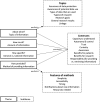Health Research with Data in a Time of Privacy: Which Information do Patients Want?
- PMID: 37309128
- PMCID: PMC10496423
- DOI: 10.1177/15562646231181439
Health Research with Data in a Time of Privacy: Which Information do Patients Want?
Abstract
When hospitals ask broad consent for the secondary use of patient data for scientific research, it is unknown for which studies the data will be used. We investigated what patients at a cancer hospital consider to be an adequate level and most suitable method of information provision using questionnaires (n = 71) and interviews (n = 24). A part of the respondents indicated that they would feel sufficiently informed by either being notified about potential further use, or by receiving a general brochure before being asked for consent. Others stated that additional information would be interesting and appreciated. Yet, when discussing required resources needed to provide additional information, interviewees lowered the bar of what they considered minimally required, voicing the importance of spending resources on research.
Keywords: patient information; research information; return of general research results; secondary use of health data; transparency.
Figures


References
-
- Aitken M., Jorre J. d. S., Pagliari C., Jepson R., Cunningham-Burley S. (2016). Public responses to the sharing and linkage of health data for research purposes: A systematic review and thematic synthesis of qualitative studies. BMC Medical Ethics, 17(1), 73. 10.1186/s12910-016-0153-x - DOI - PMC - PubMed
-
- Arksey H., Knight P. T. (1999). Achieving a successful interview. In Interviewing for Social Scientists, (pp 89–109). Thousand Oaks (CA): Sage Publications.
-
- Beckjord E. B., Rechis R., Nutt S., Shulman L., Hesse B. W. (2011). What do people affected by cancer think about electronic health information exchange? Results from the 2010 LIVESTRONG electronic health information exchange survey and the 2008 health information national trends survey. Journal of Oncology Practice, 7(4), 237–241. 10.1200/JOP.2011.000324 - DOI - PMC - PubMed
Publication types
MeSH terms
LinkOut - more resources
Full Text Sources

